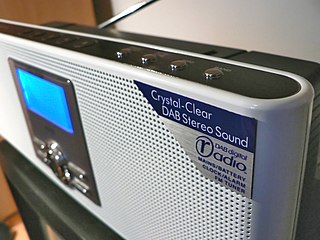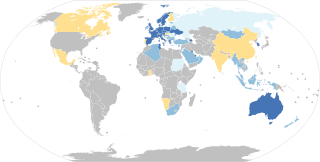
Digital television (DTV) is the transmission of television signals using digital encoding, in contrast to the earlier analog television technology which used analog signals. At the time of its development it was considered an innovative advancement and represented the first significant evolution in television technology since color television in the 1950s. Modern digital television is transmitted in high-definition television (HDTV) with greater resolution than analog TV. It typically uses a widescreen aspect ratio in contrast to the narrower format (4:3) of analog TV. It makes more economical use of scarce radio spectrum space; it can transmit up to seven channels in the same bandwidth as a single analog channel, and provides many new features that analog television cannot. A transition from analog to digital broadcasting began around 2000. Different digital television broadcasting standards have been adopted in different parts of the world; below are the more widely used standards:

Digital Video Broadcasting (DVB) is a set of international open standards for digital television. DVB standards are maintained by the DVB Project, an international industry consortium, and are published by a Joint Technical Committee (JTC) of the European Telecommunications Standards Institute (ETSI), European Committee for Electrotechnical Standardization (CENELEC) and European Broadcasting Union (EBU).

Advanced Television Systems Committee (ATSC) standards are an international set of standards for broadcast and digital television transmission over terrestrial, cable and satellite networks. It is largely a replacement for the analog NTSC standard and, like that standard, is used mostly in the United States, Mexico, Canada, South Korea and Trinidad & Tobago. Several former NTSC users, such as Japan, have not used ATSC during their digital television transition, because they adopted other systems such as ISDB developed by Japan, and DVB developed in Europe, for example.

Digital radio is the use of digital technology to transmit or receive across the radio spectrum. Digital transmission by radio waves includes digital broadcasting, and especially digital audio radio services.

SK Telecom Co., Ltd., abbreviated as SKT is a South Korean wireless telecommunications operator and former film distributor and is part of the SK Group, one of the country's largest chaebols. It leads the local market with 50.5 percent share as of 2008. SK Telecom is the largest wireless carrier in South Korea, with 23 million subscribers as of Q4 2023.

Malaysian television broadcasting was introduced on 28 December 1963. Colour television was introduced on 28 December 1978. Full-time colour transmissions were officially inaugurated on New Year's Day 1982. There are currently 16 national free-to-air terrestrial television channels in Malaysia and 3 national pay subscription television operators in Malaysia.
MobaHO! (モバHO!) was a mobile satellite digital audio/video subscription based broadcasting service in Japan, whose services began on October 20, 2004 and ended on March 31, 2009 at 3:00 pm Japan time. MobaHO! used the ISDB digital broadcast specification. The satellite, MBSat 1, providing this service was jointly owned by SK Telecom of South Korea and Mobile Broadcasting Corporation (MBCO) of Japan; TU, South Korea's now defunct S-DMB mobile television service under SK Telecom, used to share same satellite.

Munhwa Broadcasting Corporation is one of the leading South Korean television and radio broadcasters. Munhwa is the Sino-Korean word for "culture". Its flagship terrestrial television station MBC TV broadcasts as channel 11.
DVB-H is one of three prevalent mobile TV formats. It is a technical specification for bringing broadcast services to mobile handsets. DVB-H was formally adopted as ETSI standard EN 302 304 in November 2004. The DVB-H specification can be downloaded from the official DVB-H website. For a few months from March 2008, DVB-H was officially endorsed by the European Union as the "preferred technology for terrestrial mobile broadcasting".
WPPX-TV is a television station licensed to Wilmington, Delaware, United States, broadcasting the Ion Television network to the Philadelphia area. It is owned and operated by the Ion Media subsidiary of the E. W. Scripps Company and maintains offices on Main Street in Manayunk, with a transmitter in Roxborough, both sections of Philadelphia.

MediaFLO was a technology developed by Qualcomm for transmitting audio, video and data to portable devices such as mobile phones and personal televisions, used for mobile television. In the United States, the service powered by this technology was branded as FLO TV.
S-DMB (Satellite-DMB) was a hybrid version of the Digital Multimedia Broadcasting. The S-DMB used the S band (2170-2200 MHz) of IMT-2000. and delivered around 18 channels at 128 kbit/s in 15 MHz. It incorporated a high power geostationary satellite, the MBSat 1. For outdoor and light indoor coverage is integrated with a terrestrial repeater network for indoor coverage in urban areas.
Mobile television is television watched on a small handheld or mobile device, typically developed for that purpose. It includes service delivered via mobile phone networks, received free-to-air via terrestrial television stations, or via satellite broadcast. Regular broadcast standards or special mobile TV transmission formats can be used. Additional features include downloading TV programs and podcasts from the Internet and storing programming for later viewing.
DTMB is the digital TV standard for mobile and fixed devices, developed in the People's Republic of China. It is used there and in both of their special administrative regions, and also in Cambodia, the Comoros, Cuba, East Timor, Laos, Vietnam, and Pakistan. In Pakistan, as part of the China–Pakistan Economic Corridor Project, ZTE Corporation will provide Pakistan Television Corporation collaboration across several digital terrestrial television technologies, staff training, and content creation, including partnerships with Chinese multinational companies in multiple areas, such as television sets and set top boxes, as a form of "International Cooperation".
ETSI Satellite Digital Radio describes a standard of satellite digital radio. It is an activity of the European standardisation organisation ETSI.

The radio technology known as Digital Audio Broadcasting, and its TV sibling, Digital Multimedia Broadcasting (DMB), is being operated in several regions worldwide, either in the form of full services, or as feasibility studies.
Mobile TV Format is a colloquial and collective name for technology standards set out for broadcasting TV services to mobile devices, mostly mobile handsets for now. Currently, there are four prevalent formats known as DMB, DVB-H, OneSeg and MediaFLO. As of December 2007, ITU approved T-DMB, DVB-H, OneSeg and MediaFLO as the global standard for real-time mobile video and audio broadcasting. Thus far, none of the four formats has secured a dominant position in the global market, except in their respective home markets.

Digital multimedia broadcasting (DMB) is a digital radio transmission technology developed in South Korea as part of the national IT project for sending multimedia such as TV, radio and datacasting to mobile devices such as mobile phones, laptops and GPS navigation systems. This technology, sometimes known as mobile TV, should not be confused with Digital Audio Broadcasting (DAB) which was developed as a research project for the European Union.









